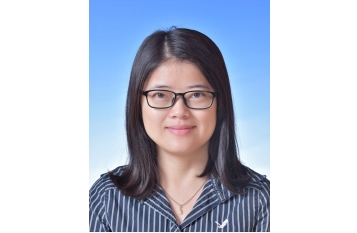
Prof. WU Haiyan
Assistant Professor (ICI-CCBS)
Office: N21-1015d
Tel: +(853) 8822 9210
E-mail: haiyanwu@um.edu.mo
- Editorial board member, Communications Psychology 2025–present
- Organizing committee, The Fourth International Workshop on Human Brain and Artificial Intelligence (HBAI 2024) 2024–present
- Editorial board member, Brain Sciences 2023–present
- Visiting associate in Psychology, California Institute of Technology, Division of the Humanities and Social Sciences 2020–present
- Executive guest editor, Current Neuropharmacology 2020–present
- Associate editor, IEEE International Conference on Development and Learning (ICDL) 2020
- Session chair of Social cognitive science, Chinese Society for Cognitive Science 2020–present
- Member of IEEE (Institute of Electrical and Electronics Engineers)
- Member of Society for Neuroscience (SfN)
- Member of Organization for Human Brain Mapping (OHBM)
- Member of China Computer Federation (CFF)
- Member of Youth Work Committee of the Chinese Association of Rehabilitation Medicine (CARM)
- Member of Guangdong-Hong Kong-Macao Greater Bay Area Brain Engineering Research Association
- Member of Social Computing and Social Intelligence Professional Committee, Chinese Society of Artificial Intelligence
- Professional member of New York Academy of Sciences
- Organizing committee, Biomedical Engineering Brain Science Sub-Forum of Guangdong Postgraduate Academic Forum 2020
- Ph.D., Cognitive Neuroscience, Beijing Normal University, Beijing, China
Professor Haiyan Wu is the Principal Investigator of ANDlab at the University of Macau (https://andlab-um.com/). Her research focuses on introducing an interdisciplinary technological framework, combining AI + brain imaging, computational models, intracranial and extracranial neural signals (EEG and iEEG), neural modulation, virtual reality, and big data to study social neuroscience. Specifically, we use diverse methods (big data, psychophysiological recordings, mouse tracking/eye tracking, computational modeling, EEG, iEEG, tDCS/TMS and fMRI) to find answers to these questions:
1) How do people make positive and negative empathetic responses to others?
2) How can we profile and measure aspects of social inference, decision making, and strategic interactions in different individuals?
3) What is the role of mentalizing in social emotion and decision making?
4) How do the reward and punishment systems interact during decision making?
- 2025-2028 Science and Technology Development Fund (FDCT) of Macau (0112/2024/RIA2).
- 2022–2025 Science and Technology Development Fund (FDCT) of Macau (0041/2022/A).
Completed
- 2023–2024 Neural Mechanisms of Cognitive Control in Decision Making (MYRG2022-00188-ICI).
- 2021–2024 Science and Technology Development Fund (FDCT) of Macau (0127/2020/A3).
- 2021–2023 Natural Science Foundation of Guangdong Province (2021A1515012509).
- 2021–2023 SRG of University of Macau (SRG202000027-ICI).
- 2021–2023 Shenzhen-Hong Kong-Macao Science and Technology Innovation Project (Category C) (SGDX2020110309280100).
- 2018–2021 Neural Mechanism of Dishonesty in Social Interactions, supported by The National Natural Science Foundation of China (NSFC).
- 2014–2017 The Neural Mechanism of Group Identity Effect on Empathy, supported by The National Natural Science Foundation of China (NSFC).
Instructor, GESB1014*, PSYCHOLOGY and INTELLIGENT TECHNOLOGY, [U], University of Macau, 2024S, 2025S
Instructor, Cognitive Neuroscience* [G], University of Macau: 2021S, 2022S, 2023S,
Instructor, Artificial Intelligence and Human Cognition*[U], University of Macau: 2021S, 2022S, 2023S, 2024S
- Zhang, H., Cheng, J., Hu, K., Wang, F., Qi, S., Liu, Q., Yao, Y., Mobbs, D., and Wu, H. (2024). An intracranial dissection of human escape circuits. Nature Communications. (in press)
- Xu, X.J., Liu, X., Hu, X., and Wu, H. (2025). The trajectory of crime: Integrating mouse-tracking into concealed memory detection. Behavior Research Methods, 57, 78.
- Cao, S., Fu, D., Yang, X., Wermter, S., Liu, X., and Wu, H. (2024). Can AI detect pain and express pain empathy? A review from emotion recognition and a human-centered AI perspective. iScience, 27(8), 110570.
- Mou, X., He, C., Tan, L., Yu, J., Liang, H., Zhang, J., Tian, Y., Yang, Y., Xu, T., Wang, Q., Cao, M., Chen, Z., Hu, C., Wang, X., Liu, Q., and Wu, H. (2024). ChineseEEG: A Chinese linguistic corpora EEG dataset for semantic alignment and neural decoding. Scientific Data, 11, 550.
- Hu, K., Wang, R., Zhao, S., Yin, E., and Wu, H. (2024). The association between social rewards and anxiety: Links from neurophysiological analysis in virtual reality and social interaction game. NeuroImage.
- Qu, Y., Fu, K., Wang, L., Zhang, Y., Wu, H., and Liu, Q. (2024). Hypergraph-based multitask feature selection with temporally constrained group sparsity learning on fMRI. Mathematics, 12(11), 1733.
- Qu, Y., Wei, C., Du, P., Che, W., Zhang, C., Ouyang, W., Bian, Y., Xu, F., Hu, B., Du, K., Wu, H., Liu, J., and Liu, Q. (2024). Integration of cognitive tasks into artificial general intelligence test for large models. iScience, 27(4), 109550.
- Tan, L., Cheng, J., Kang, C., Xu, H., and Wu, H. (2024). Cognitive and affective flexibility: Processing mechanisms and their impact on mental health. Chinese Science Bulletin.
- Tian, Y., Huang, Q., Liu, X., Zhang, J., Ye, Y., and Wu, H. (2024). Unraveling the intricacies of curiosity: A comprehensive study of its measures in the Chinese context. PsyCH Journal. (in press)
- Xu, H., Yang, G., Wu, H., Xiao, J., Li, Q., and Liu, X. (2024). Distinct mechanisms underlying cross-modal semantic conflict and response conflict processing. Cerebral Cortex, 34(2), bhad539.
- Yang, G., Wu, H., Li, Q., Liu, X., Fu, Z., and Jiang, J. (2024). Dorsolateral prefrontal activity supports a cognitive space organization of cognitive control. eLife, 12, RP87126.
- Zhang, S., Tian, Y., Liu, Q., and Wu, H. (2023). The neural correlates of ambiguity and risk in human decision-making under an active inference framework. eLife, 13, RP92892.
- Zhang, H., Chen, K., Bao, J., and Wu, H. (2023). Oxytocin enhances the triangular association among behavior, resting-state, and task-state functional connectivity. Human Brain Mapping, 44(17), 6074–6089.
- Li, Z., Dong, Q., Hu, B., and Wu, H. (2023). Every individual makes a difference: A trinity derived from linking individual brain morphometry, connectivity, and mentalising ability. Human Brain Mapping, 44(8), 3343–3358.
- Qi, Y., Liu, Z., Cao, S., Han, Y., Wang, Q., Liu, X., and Wu, H. (2023). Social value orientation modulates behavioral and neural responses to social influence. Human Brain Mapping, 44(8), 3222–3231.
- Yang, G., Wu, H., Li, Q., Liu, X., Fu, Z., and Jiang, J. (2023). Conflicts are represented in a cognitive space to reconcile domain-general and domain-specific cognitive control. eLife, 12.
- Zhang, H., Zhang, K., Zhang, Z., Zhao, M., Liu, Q., Luo, W., and Wu, H. (2023). Social conformity is associated with inter-trial electroencephalogram variability. Annals of the New York Academy of Sciences, 1523(1), 104–118.
- Chen, K., Wang, R., Huang, J., Gao, F., Yuan, Z., Qi, Y., and Wu, H. (2022). A resource for assessing dynamic binary choices in the adult brain using EEG and mouse-tracking. Scientific Data, 9(416).
- Wu, Q., Huang, Q., Liu, C., & Wu, H. (2022). Oxytocin modulates social brain network correlations in resting and task state. Cerebral Cortex.
- Cao, S., Liu, X., & Wu, H. (2022). The neural mechanisms underlying effort process modulated by efficacy. Neuropsychologia, 173, 108314.
- Cao, S.-Q., Tang, C.-C., Wu, H.-Y., & Liu, X. (2022). Value Analysis determines when and how to strive. Advances in Psychological Science, 30(4), 877–887.
- Wang, Y., Wang, R., & Wu, H*. (2022). The role of oxytocin in modulating self-other distinction brain: a pharmacological fMRI study. Cerebral Cortex.
- Pang, L., Li, H., Liu, Q., Luo, Y. J*., Mobbs, D., & Wu, H*. (2022). Resting-state functional connectivity of social brain regions predicts motivated dishonesty. NeuroImage.
- Wu, H., & Fung, B. J.. (2022). Mentalizing during social interaction: the development and validation of the interactive mentalizing questionnaire. Front. Psychol. 12:791835.
- Yang, G., Xu, H., Li, Z., Nan, W., Wu, H., Li, Q., & Liu, X. (2021). The Congruency Sequence Effect Is Modulated by the Similarity of Conflicts. Journal of Experimental Psychology: Learning, Memory, and Cognition.
- Shuguang Wei, Zhaoxia Xue, Wujun Sun, Jie Han, Haiyan Wu*, Xun Liu*. (2021). Altered neural processing of reward and punishment in women with methamphetamine use disorder. Frontiers in Psychiatry.
- Shuhan Zheng, Zhichao Liang, Youzhi Qu, Qingyuan Wu, Haiyan Wu*, Quanying Liu*. (2021). Kuramoto model based analysis reveals oxytocin effects on brain network dynamics. International Journal of Neural Systems.
- Tanaz Molapour, Cindy C Hagan, Brian Silston, Haiyan Wu, Maxwell Ramstead, Karl Friston, Dean Mobbs. (2021). Seven computations of the social brain. Social Cognitive and Affective Neuroscience, 745-760.
- Huang, Q., Cao, S., Zhou, S., Punia, D., Zhu, X., Luo, Y., & Wu, H.. (2021). How anxiety predicts interpersonal curiosity during the COVID-19 pandemic: The mediation effect of interpersonal distancing and autistic tendency. Personality and Individual Differences, 180, 110973.
- Zheng, S., Punia, D., Wu, H., & Liu, Q.. (2021). Graph theoretic analysis reveals intranasal oxytocin induced network changes over frontal regions. Neuroscience, 459, 153-165.
- Wu, H., Liu, X., Hagan, C. C., & Mobbs, D. (2020). Mentalizing during social InterAction: A four component model. Cortex, 126, 242-252.
- Wei S, Liu Q, Harrington M, Sun J, Yu H, Han J, Hao M, Wu H, and Liu X. (2020). Nonconformist tendencies related to risky choices in female methamphetamine abstainers. The American journal of drug and alcohol abuse, 46(1), 68-77.
- Qi, Y., Nan, W., Cai, H., Wu, H., & Liu, X. (2020). Empathy or schadenfreude? Social value orientation and affective responses to gambling results. Personality and Individual Differences, 153, 1096.
- Wu, H., Feng, C., Lu, X., Liu, X., & Liu, Q. (2020). Oxytocin effects on the resting-state mentalizing brain network. Brain imaging and behavior, 14, 2530-2541.
(2018) Supervision award: PhD student Yanyan Qi wins the Awards of CAS
(2017) Outstanding associate professor of Institute of Psychology, CAS
(2010) Outstanding graduate student of Zhejiang Normal University
2020.08 – now University of Macau, Centre for Cognitive and Brain Sciences, Assistant Professor, Department of Psychology, University of Macau
2017.10 – 2019.01, 2024 – California Institute of Technology, Pasadena, US, Visiting Associate Humanities and Social Sciences
2017.03 – 2020.07 Institute of Psychology, Chinese Academy of Sciences, Associate Professor Department of Psychology, University of Chinese Academy of Sciences, Beijing
2013.07 – 2017.02 Institute of Psychology, Chinese Academy of Sciences, Assistant Professor, Department of Psychology, University of Chinese Academy of Sciences, Beijing



